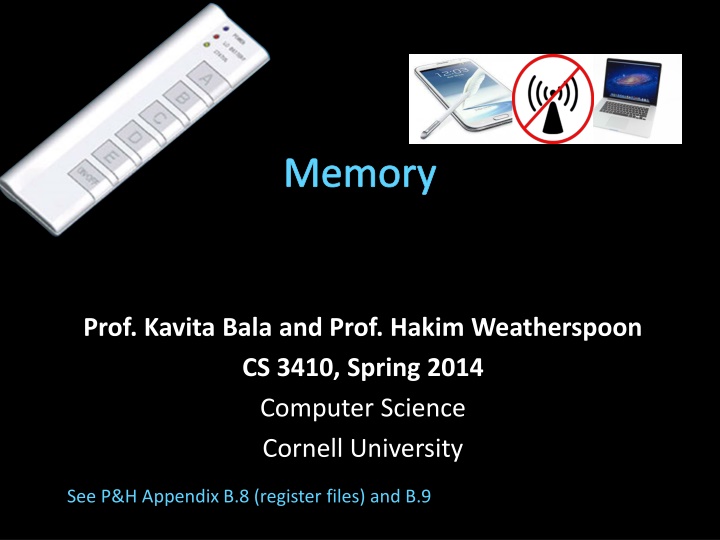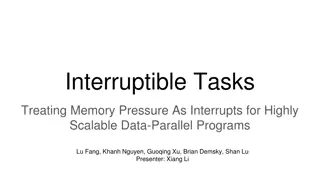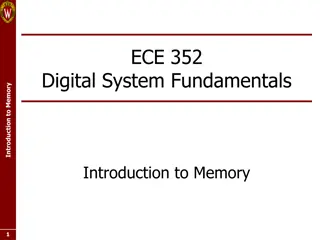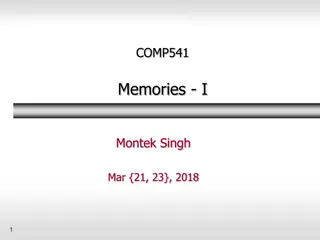
CS 3410 Spring 2014 Cornell: Memory Management and Processor Design
Explore CS 3410 course materials focusing on memory management, processor building, collaboration policies, and course logistics at Cornell University in Spring 2014. Learn about finite state machines, CPU register files, memory scaling technologies like SRAM and DRAM, and design a single-cycle processor. Stay informed about assignments, deadlines, lab sections, and grading policies.
Download Presentation

Please find below an Image/Link to download the presentation.
The content on the website is provided AS IS for your information and personal use only. It may not be sold, licensed, or shared on other websites without obtaining consent from the author. If you encounter any issues during the download, it is possible that the publisher has removed the file from their server.
You are allowed to download the files provided on this website for personal or commercial use, subject to the condition that they are used lawfully. All files are the property of their respective owners.
The content on the website is provided AS IS for your information and personal use only. It may not be sold, licensed, or shared on other websites without obtaining consent from the author.
E N D
Presentation Transcript
Memory Prof. Kavita Bala and Prof. Hakim Weatherspoon CS 3410, Spring 2014 Computer Science Cornell University See P&H Appendix B.8 (register files) and B.9
Administrivia Make sure to go to your Lab Section this week Completed Lab1 due before winter break, Friday, Feb 14th Note, a Design Document is due when you submit Lab1 final circuit Work alone Save your work! Save often. Verify file is non-zero. Periodically save to Dropbox, email. Beware of MacOSX 10.5 (leopard) and 10.6 (snow-leopard) Homework1 is out Due a week before prelim1, Monday, February 24th Work on problems incrementally, as we cover them in lecture Office Hours for help Work alone Work alone, BUT use your resources Lab Section, Piazza.com, Office Hours Class notes, book, Sections, CSUGLab
Administrivia Check online syllabus/schedule http://www.cs.cornell.edu/Courses/CS3410/2014sp/schedule.html Slides and Reading for lectures Office Hours Homework and Programming Assignments Prelims (in evenings): Tuesday, March 4th Thursday, May 1th Schedule is subject to change
Collaboration, Late, Re-grading Policies Black Board Collaboration Policy Can discuss approach together on a black board Leave and write up solution independently Do not copy solutions Late Policy Each person has a total of four slip days Max of two slip days for any individual assignment Slip days deducted first for any late assignment, cannot selectively apply slip days For projects, slip days are deducted from all partners 25% deducted per day late after slip days are exhausted Regrade policy Submit written request to lead TA, and lead TA will pick a different grader Submit another written request, lead TA will regrade directly Submit yet another written request for professor to regrade.
Big Picture: Building a Processor inst memory register file alu +4 +4 addr =? PC din dout control cmp offset memory target new pc imm extend A Single cycle processor
Goals for today Review Finite State Machines Memory CPU: Register Files (i.e. Memory w/in the CPU) Scaling Memory: Tri-state devices Cache: SRAM (Static RAM random access memory) Memory: DRAM (Dynamic RAM)
Goal: How do we store results from ALU computations? How do we use stored results in subsequent operations? Register File How does a Register File work? How do we design it?
Big Picture: Building a Processor inst memory register file alu +4 +4 addr =? PC din dout control cmp offset memory target new pc imm extend A Single cycle processor
Register File Register File N read/write registers Indexed by register number QA 32 DW Dual-Read-Port Single-Write-Port 32 x 32 Register File 32 QB 32 W RWRA RB 1 5 5 5
Tradeoffsa 8-to-1 mux Register File tradeoffs + Very fast (a few gate delays for both read and write) + Adding extra ports is straightforward Doesn t scale e.g. 32MB register file with 32 bit registers Need 32x 1M-to-1 multiplexor and 32x 20-to-1M decoder How many logic gates/transistors? b c d e f g h s2s1s0
Takeway Register files are very fast storage (only a few gate delays), but does not scale to large memory sizes.
Goals for today Memory CPU: Register Files (i.e. Memory w/in the CPU) Scaling Memory: Tri-state devices Cache: SRAM (Static RAM random access memory) Memory: DRAM (Dynamic RAM)
Next Goal How do we scale/build larger memories?
Building Large Memories Need a shared bus (or shared bit line) Many FlipFlops/outputs/etc. connected to single wire Only one output drives the bus at a time D0 S0 D1 S1 D2 S2 D3 S3 D1023 S1023 shared line How do we build such a device?
Tri-State Devices Tri-State Buffers If enabled (E=1), then Q = D Otherwise, Q is not connected (z = high impedance) E D Q E D 0 0 0 1 1 0 1 1 Q z z 0 1
Tri-State Devices Tri-State Buffers If enabled (E=1), then Q = D Otherwise, Q is not connected (z = high impedance) E Vsupply D Q D Q E D 0 0 0 1 1 0 1 1 Q z z 0 1 Gnd
Tri-State Devices Tri-State Buffers If enabled (E=1), then Q = D Otherwise, Q is not connected (z = high impedance) E Vsupply E D Q D Q E D 0 0 0 1 1 0 1 1 Q z z 0 1 Gnd
Shared Bus S2 S3 D3 D0 S0 D1 S1 D2 D1023 S1023 shared line
Takeway Register files are very fast storage (only a few gate delays), but does not scale to large memory sizes. Tri-state Buffers allow scaling since multiple registers can be connected to a single output, while only one register actually drives the output.
Goals for today Memory CPU: Register Files (i.e. Memory w/in the CPU) Scaling Memory: Tri-state devices Cache: SRAM (Static RAM random access memory) Memory: DRAM (Dynamic RAM)
Next Goal How do we build large memories? Use similar designs as Tri-state Buffers to connect multiple registers to output line. Only one register will drive output line.
SRAM Static RAM (SRAM) Static Random Access Memory Essentially just D-Latches plus Tri-State Buffers A decoder selects which line of memory to access (i.e. word line) A R/W selector determines the type of access That line is then coupled to the data lines Data Address Decoder
SRAM Static RAM (SRAM) Static Random Access Memory Essentially just D-Latches plus Tri-State Buffers A decoder selects which line of memory to access (i.e. word line) A R/W selector determines the type of access That line is then coupled to the data lines 22 Address SRAM 4M x 8 8 8 Din Dout Chip Select Write Enable Output Enable
SRAM Din[1] Din[2] E.g. How do we design a 4 x 2 SRAM Module? D Q D Q enable enable 0 (i.e. 4 word lines that are each 2 bits wide)? D Q 2-to-4 decoder D Q enable enable 1 2 4 x 2 SRAM D Q D Q Address enable enable 2 D Q D Q enable enable 3 Write Enable Output Enable Dout[1] Dout[2]
SRAM Din[1] Din[2] E.g. How do we design a 4 x 2 SRAM Module? D Q D Q enable enable 0 (i.e. 4 word lines that are each 2 bits wide)? D Q 2-to-4 decoder D Q enable enable 1 2 D Q D Q Address enable enable 2 D Q D Q enable enable 3 Write Enable Output Enable Dout[1] Dout[2]
Bit line SRAM Word line Din[1] Din[2] E.g. How do we design a 4 x 2 SRAM Module? D Q D Q enable enable 0 (i.e. 4 word lines that are each 2 bits wide)? D Q 2-to-4 decoder D Q enable enable 1 2 D Q D Q Address enable enable 2 D Q D Q enable enable 3 Write Enable Output Enable Dout[1] Dout[2]
SRAM Din[1] Din[2] E.g. How do we design a 4 x 2 SRAM Module? D Q D Q enable enable 0 (i.e. 4 word lines that are each 2 bits wide)? D Q 2-to-4 decoder D Q enable enable 1 2 4 x 2 SRAM D Q D Q Address enable enable 2 D Q D Q enable enable 3 Write Enable Output Enable Dout[1] Dout[2]
SRAM Din 8 E.g. How do we design a 4M x 8 SRAM Module? (i.e. 4M word lines that are each 8 bits wide)? 22 4M x 8 SRAM Address Chip Select Write Enable Output Enable 8 Dout
SRAM E.g. How do we design a 4M x 8 SRAM Module? 4M x 8 SRAM 12 x 4096 decoder 4k x 1024 SRAM 4k x 1024 SRAM 4k x 1024 SRAM 4k x 1024 SRAM 4k x 1024 SRAM 4k x 1024 SRAM 4k x 1024 SRAM 4k x 1024 SRAM 12 Address [21-10] 1024 1024 1024 1024 1024 1024 1024 1024 Address [9-0]10 mux mux mux mux mux mux mux mux 1 1 1 1 1 1 1 1 Dout[5] Dout[4] Dout[1] Dout[0] Dout[7] Dout[6] Dout[3] Dout[2]
SRAM E.g. How do we design a 4M x 8 SRAM Module? 4M x 8 SRAM Row decoder 4k x 1024 SRAM 4k x 1024 SRAM 4k x 1024 SRAM 4k x 1024 SRAM 4k x 1024 SRAM 4k x 1024 SRAM 4k x 1024 SRAM 4k x 1024 SRAM 12 Address [21-10] 1024 1024 1024 1024 1024 1024 1024 1024 Address [9-0]10 column selector, sense amp, and I/O circuits Chip Select (CS) R/W Enable 8 Shared Data Bus
SRAM Modules and Arrays R/W 4M x 8 SRAM 4M x 8 SRAM 4M x 8 SRAM 4M x 8 SRAM A21-0 CS msb lsb CS Bank 2 CS Bank 3 CS Bank 4
SRAM Summary SRAM A few transistors (~6) per cell Used for working memory (caches) But for even higher density
Dynamic RAM: DRAM bit line Dynamic-RAM (DRAM) Data values require constant refresh word line Capacitor Gnd Each cell stores one bit, and requires 1 transistors
DRAM vs. SRAM Single transistor vs. many gates Denser, cheaper ($30/1GB vs. $30/2MB) But more complicated, and has analog sensing Also needs refresh Read and write back every few milliseconds Organized in 2D grid, so can do rows at a time Chip can do refresh internally Hence slower and energy inefficient
Memory Register File tradeoffs + Very fast (a few gate delays for both read and write) + Adding extra ports is straightforward Expensive, doesn t scale Volatile Volatile Memory alternatives: SRAM, DRAM, Slower + Cheaper, and scales well Volatile Non-Volatile Memory (NV-RAM): Flash, EEPROM, + Scales well Limited lifetime; degrades after 100000 to 1M writes
Summary We now have enough building blocks to build machines that can perform non-trivial computational tasks Register File: Tens of words of working memory SRAM: Millions of words of working memory DRAM: Billions of words of working memory NVRAM: long term storage (usb fob, solid state disks, BIOS, ) Next time we will build a simple processor!






















